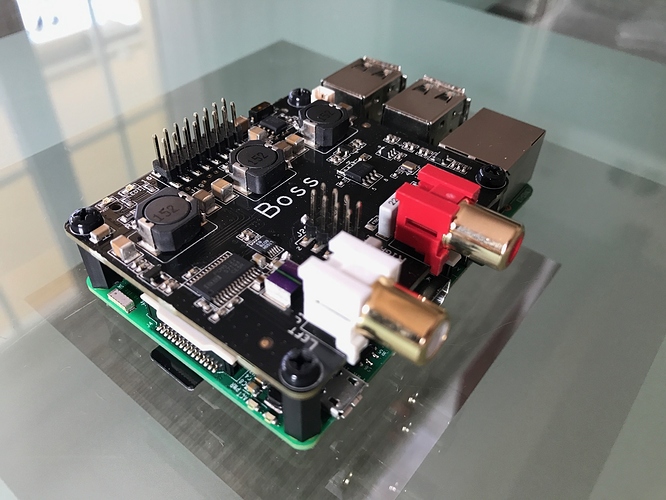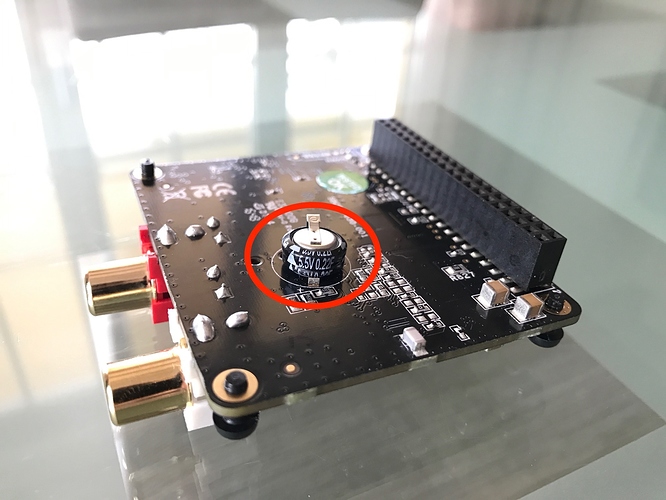I had today opportunity to test the new Allo DAC Boss. It is another great product from Allo @allo.com , and in my view has three interesting differentiations:
First of all, it has such a deep, deep, low, juicy bass flowing out and projects powerful sound stage!
According to Allo the foundation for this unique performance is the Supercapacitor of 0.22F…!!! you see in this picture. I personally would have given to this DAC product name “Bass" not “Boss”…

Second, notable differentiation is very low noise floor. On 0dB volume the Boss is almost completely silent. While I can hear some 50Hz noise from Kali+Allo DAC, and quite high 50Hz and to shielding sensitive high frequency noise from Audiphonics 9018K2M DAC.
Finally, it is a master DAC. It has two high quality clocks (44.1 and 48 kHz) on the board running not only the DAC itself, but also sending accurate BSK clock of 44.1 or 48 kHz (depending on the music encoding ) to Raspberry Pi, based on which then Raspberry Pi is timing LRCLK (frame) & Data and in return sending both back to the DAC trough i2s. The result - reduced jitter! I my hearing not as low and accurate as Kali+Allo. However, the two 44.1 or 48 kHz master clocks enable extremely low jitter level for this budget DAC, and result in much better sound quality than majority of slave DACs feeding from the single inaccurate Raspberry PI clock.
Now here is my scoring of Allo Boss vs. the two best Raspberry Pi DAC alternatives in the market currently - Allo Kali+Piano and Audiophonics 9018K2M.

While above differentiations clearly make this DAC to stand out with the best bass and lowest noise floor. In my subjective perception the sound reproduction dynamics, accuracy, and transparency is not as good as other two top DACs, and voice presentation in vocals is not ideal.
While mens vocals get good lower tones and deeper voices, they are bloated and washed together with lower frequencies; thus, lacking clarity and separation. Even more noticeable it is for women vocals, where voices besides being bloated and washed together with lower frequencies, are getting unnecessary lower tonality mix-in and shift. Here Audiphonics is standing out and leading the crowd with by far the most natural, best presented, and accurate voice reproduction. Also Kali+Allo combination is also better sounding that Boss.
My subjective conclusion.
Allo Boss is by far the best quality entry level DAC in the market competitively priced at 59$ vs. HiFiBerry, IQaudIO, etc.
However, it is not as good as the two best more expensive alternatives - combination of Allo Kali + Piano at 120$, or Audiophonics 9018K2M at 110$.
I think Allo Boss is ideal DAC for general public and specially bass lowers, Allo Kali+Piano for Pop & Rock lowers, and Audiophonics for Vocals aficionados.

P.S. @Dan_Knight just has created 192 kHz drivers for Boss on DietPi in the development set-up. They work perfect, but need to be enhanced for 384 kHz playback still, and populated in the next public version kernel.



 I personally don’t think the electrons care. I can understand it might sound different but an improvement always seems to be the basic assumption. I don’t buy it’s always an improvement. That’s just my engineering mind.
I personally don’t think the electrons care. I can understand it might sound different but an improvement always seems to be the basic assumption. I don’t buy it’s always an improvement. That’s just my engineering mind.